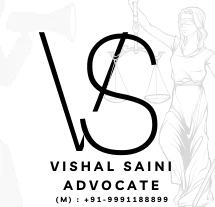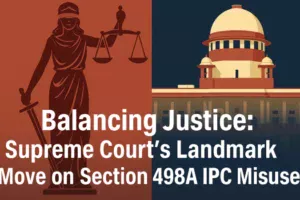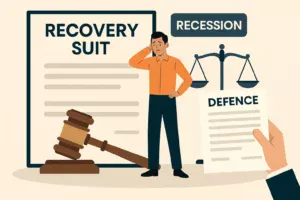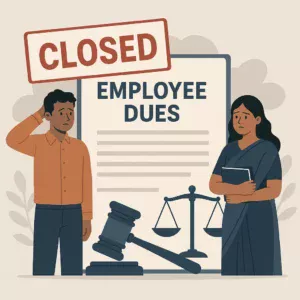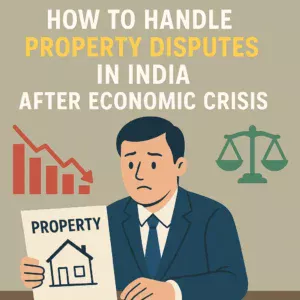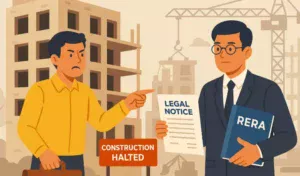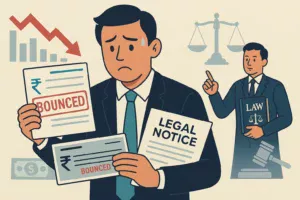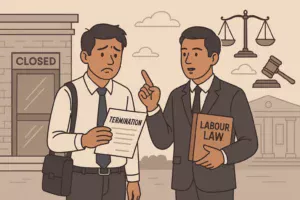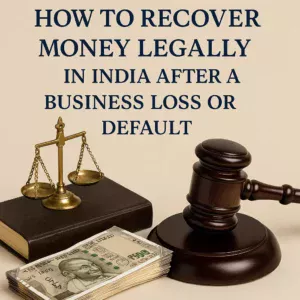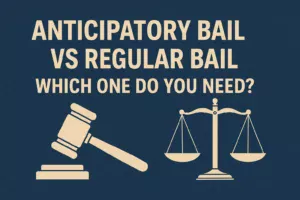To reach the ultimate verdict in a civil case, a variety of procedural stages must be taken. A claim for damages or compensation for losses is the main focus of civil lawsuits, which are frequently connected to financial transactions or property disputes. in this article, I have explained about stages of civil litigation.
A civil suit is one in which one or more parties are accused of breaking civil law. Instances of civil lawsuits arise when one person wrongs another. The parties or litigants, in this case, relate to both individuals. The settlement of disputes that are not criminal in nature is the subject of civil litigation. The Code of Civil Procedure, 1908, governs civil court cases.
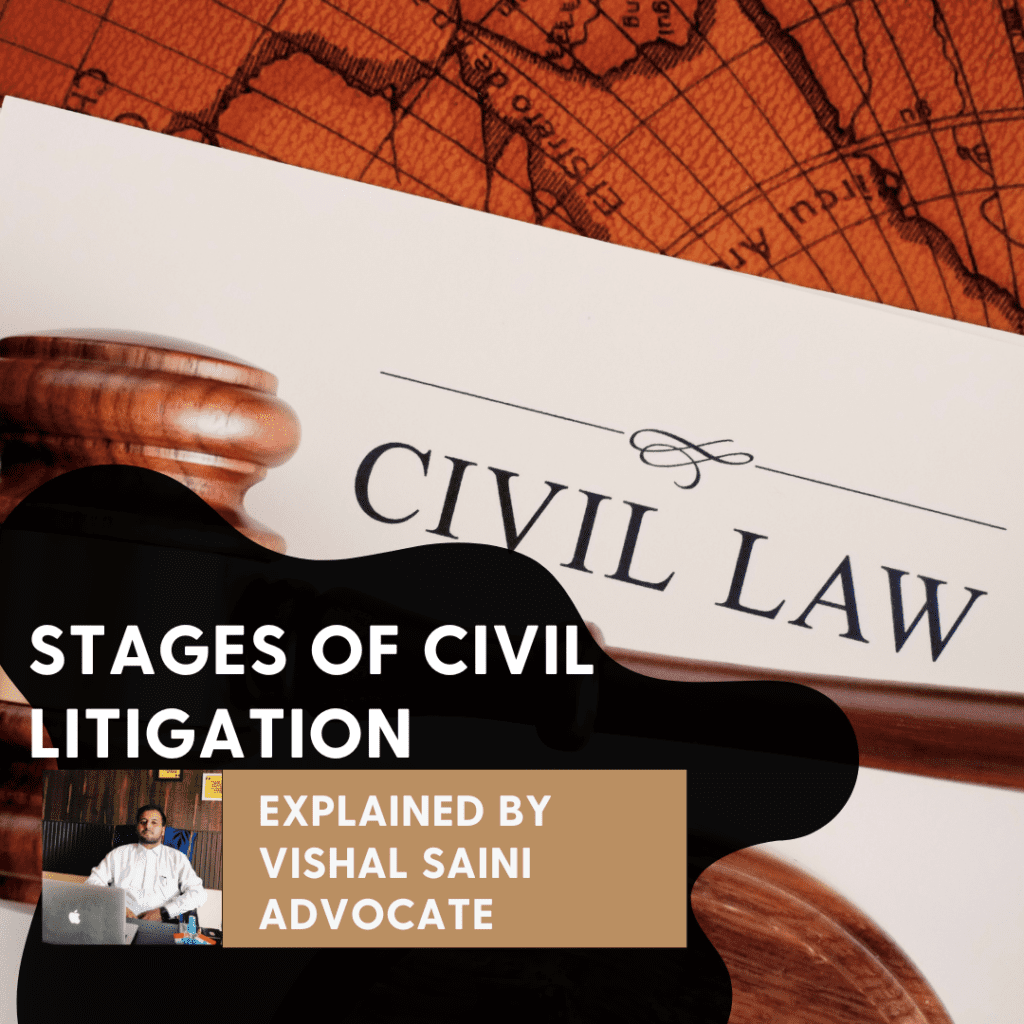
Additionally, laws like the Transfer of Property Act, 1882, the Trademarks Act, 1999, and the Indian Contract Act, 1872, among others, control civil law in India. The goal of civil litigation, in brief, is to provide solutions for problems that are of a civil or business nature. It is the result of numerous acts and laws. Instead of imposing punishment or levying penalties, as in the case of criminal litigation, the focus of civil litigation is on the settlement of damages or paying the party that was harmed. There are, however, some crimes for which the relevant laws guarantee both civil and criminal remedies.
Stages of Civil Litigation
From the time of the initial filing until the announcement of the final judgement, civil litigation proceeds through the following phases:
1. Filing of Plaint
The plaint, a legal document, contains the case’s facts and an overview. The plaint serves as the foundation for the litigation because it contains the facts that form the basis of the case. The specifics of the plaint are outlined in Order VII of the Code of Civil Procedure, 1908. Among them are:
- Name of the court where the dispute is being heard
- Information on the parties involved in the civil dispute
- A case’s facts
- The plaintiff’s requests for remedy or compensation
- The supporting documentation for the case’s facts.
2. Serving summonses
A summons is sent to the defendant who is the subject of the lawsuit once the court accepts the plaint. The defendant must appear in court in person or through a representative appointed by law. The Code of Civil Procedure, 1908 does not define the word “summon,” rather it is just a writ that indicates that legal action has been begun against the defendant. Within 30 days of the day the lawsuit was filed, the summons is issued. The summons demands that the defendant appears in court so that he or she might have a chance to be heard. In contrast, if the defendant agrees to the plaintiff’s claim even before the summons is issued, there is no need for the summons to be issued in the first place, and the plaintiff will receive a favourable decision.
3. The parties to the dispute’s attendance
The parties to whom the summons was delivered are obligated to appear in court on the designated date and time. If the parties don’t show up, an ex parte order will be made in the plaintiff’s favour. Even after providing both parties a fair chance to appear in court on the scheduled date, the judge may choose to dismiss the matter if neither party shows up.
4. Interlocutory Proceedings
Before a final ruling is made, a civil lawsuit must go through a protracted and complex process that includes several phases. Most of the time, the Court is required to step in and maintain the status quo. The plaintiff may ask for the status quo order by submitting a notice of motion to the City Civil Court or by submitting the necessary application to the High Court of the relevant jurisdiction. An interim injunction is more like an interlocutory order, to put it simply.
Even if it primarily addresses problems related to the primary disagreement in the action, an interlocutory order frequently aids in the development of the case. The issuance of interlocutory proceedings is more often in cases involving the temporary sale of real estate, the maintenance of detainees, the appointment of a court receiver, etc.
5. Written Statement
The defendant’s arguments against the plaintiff’s plaint are mentioned in the written statement. Within 30 days of the defendant being served with the summons, the written statement must be submitted. Every allegation made by the plaintiff in the plaint must be expressly refuted by the defendant in the written statement. If necessary, the defendant may include counterclaims against the plaintiff in the written statement.
6. Examination
The acceptance or denial of the charges made by the plaintiff by the defendants is noted by the Court once the written statement has been filed. The next step is to conduct the examination of the parties after the plaint and written statement has been filed.
7. Framing of the Relevant Issues
The parties will be permitted to submit the problems once the litigation procedure begins and the written statement is filed. The final set of issues will be framed by the Court after it has reviewed the draught issues. The court would examine the proposal of the dispute’s facts and formulate the issues following the first hearing, after analysing the plaint and the written declaration.
8. Documents Required
The parties must provide the necessary papers to support their claims after the problems have been framed. A request to the court to issue summonses to the parties in question to obtain the desired papers must be made if the parties wish to produce documents that are in the hands of a third party. In such cases, the parties to the dispute are responsible for paying the court’s mandatory fee.
9. Inspection and Discovery of the Documents
The parties may ask the court to inspect the documents after they have been submitted. The parties may have access to the necessary papers with the court’s approval. However, the opposition parties are free to accept or reject the materials.
10. Producing the Required Documents
The documents must be produced in court after the list of documents has been submitted to the court and depending on whether it has been accepted or rejected.
11. Examination and Cross-examining Or Questioning the Witnesses
The trial’s witness examination phase is the most crucial one. The court asks the parties if they agree with or dispute the accusations made by the opposition during the first hearing of the case. Unless the defence can show otherwise, the plaintiff often receives the first opportunity to speak. The plaintiff is required to produce the supporting documentation, and the defendant’s attorney has the opportunity to cross-examine the plaintiff and any plaintiff-side witnesses. Additionally, the plaintiff’s attorney has the opportunity to question a witness from the defendant’s perspective.
12. Arguments on merits
The next phase of civil litigation is taking the arguments once the processes of examination and cross-examination are finished. The disputing parties are invited to submit their positions, a synopsis of the facts, and a list of supporting evidence.
13. Judgment
The verdict is the next phase of the legal process. The judge of the relevant court renders the decision on which the decree will be issued after examining the merits of the case and the arguments put forward.
14. Appeals, review, and revisions of the final judgement
One of the parties may request a review of the decision within 30 days of the date of the judgement if they are not happy with it after it has been rendered. A higher court may also accept an appeal within 60 to 90 days after the day the verdict was announced, or the aggrieved party may choose to file a revision petition within the same time frame.
15. Execution of a Decree
The decree’s execution, or forcing the judgement debtor to comply with the decree’s or order’s requirements, depending on the circumstances, is the last phase. When the creditor obtains the money that was owed to them or the claims that were specified in the judgement order, the decree is considered to have been executed.
Therefore, unlike criminal litigation where sanctions and penalties are given weight, compensation is given the proper consideration in civil action. Additionally, the lawsuit may be dismissed if the aforementioned processes in the litigation process are not followed.
Read more,
FAQ ( FREQUENTLY ASKED QUESTIONS)
- Q: What is civil litigation?
- A: Civil litigation refers to the legal process of resolving disputes between parties where one party claims harm or loss caused by another, often seeking compensation.A civil suit begins with filling the plaint and then notice is served to the defendant then the court asks reply from the defendant. After that Issues are framed then Examination and cross-examination of witnesses at the Last Judgement
- Q: What laws govern civil litigation in India?
- A: The primary law governing civil litigation in India is the Code of Civil Procedure, 1908, along with other relevant laws such as the Transfer of Property Act, 1882, Trademarks Act, 1999, and the Indian Contract Act, 1872.
- Q: What is the initial document in civil litigation?
- A: The initial document is the “plaint,” which outlines the facts of the case and serves as the foundation for the litigation.
- Q: What information does the plaint include?
- A: The plaint includes details like the court’s name, information on parties, case facts, plaintiff’s requests for remedy, and supporting documentation.
- Q: What happens after the plaint is filed?
- A: Once the plaint is filed, a summons is issued to the defendant, notifying them of the legal action.
- Q: What is the purpose of serving a summons?
- A: The summons informs the defendant of the legal proceedings and requires their appearance in court to respond to the allegations.
- Q: What if the defendant does not respond to the summons?
- A: If the defendant fails to respond within 30 days, the court may issue an ex parte order in favor of the plaintiff.
- Q: What are interlocutory proceedings in civil litigation?
- A: Interlocutory proceedings involve interim orders issued by the court to maintain the status quo before a final judgment.
- Q: How is a written statement used in civil litigation?
- A: The defendant submits a written statement within 30 days, refuting the plaintiff’s allegations and presenting their arguments.
- Q: Can the defendant include counterclaims in the written statement?
- A: Yes, the defendant can include counterclaims against the plaintiff in the written statement if necessary.
- Q: What is the examination phase in civil litigation?
- A: After the plaint and written statement, the court notes the defendant’s acceptance or denial of charges, and examination of parties follows.
- Q: What are relevant issues in civil litigation?
- A: Parties submit issues for consideration, and the court frames the final set of issues after reviewing proposals.
- Q: What documents are required in civil litigation?
- A: Parties must provide necessary papers to support their claims after the issues have been framed.
- Q: What is the purpose of inspection and discovery of documents?
- A: Parties may request the court to inspect submitted documents, allowing access to necessary papers.
- Q: What happens after the submission of documents in civil litigation?
- A: The documents must be produced in court based on acceptance or rejection, following the list submitted to the court.
- Q: What is the significance of witness examination in civil litigation?
- A: Witness examination is crucial, as it determines the acceptance or denial of charges and allows parties to present evidence.
- Q: How are arguments presented in civil litigation?
- A: Arguments on merits are presented once the processes of examination and cross-examination are finished.
- Q: Who issues the final judgment in civil litigation?
- A: The judge of the relevant court issues the final judgment after examining the merits of the case and arguments presented.
- Q: Can parties appeal the final judgment in civil litigation?
- A: Yes, within 30 days of the judgment, parties can request a review, file appeals within 60 to 90 days, or file a revision petition.
- Q: What is the execution of a decree in civil litigation?
- A: It is the last phase involving enforcing the judgment, ensuring compliance with the decree’s requirements.
- Q: What happens if a party is not satisfied with the judgment?
- A: If dissatisfied, a party can request a review within 30 days or file an appeal or revision petition within 60 to 90 days.
- Q: What is the role of the higher court in civil litigation?
- A: The higher court may accept appeals within 60 to 90 days after the judgment or hear revision petitions.
- Q: How is a decree considered executed in civil litigation?
- A: The decree is considered executed when the creditor receives the owed money or specified claims mentioned in the judgment.
- Q: Can a civil lawsuit be dismissed?
- A: Yes, a civil lawsuit may be dismissed if the procedural steps in the litigation process are not followed.
- Q: How does civil litigation differ from criminal litigation?
- A: Unlike criminal litigation, civil litigation focuses on compensation rather than sanctions or penalties.
- Q: What is the time frame for filing a review in civil litigation?
- A: Parties can request a review of the judgment within 30 days of the date of the judgment.
- Q: When is a summons issued in civil litigation?
- A: The summons is issued within 30 days of filing the lawsuit and demands the defendant’s appearance in court.
- Q: What is the significance of interlocutory orders in civil litigation?
- A: Interlocutory orders help maintain the status quo and address specific issues related to the primary dispute during the legal process.
- Q: Are there specific laws governing civil litigation in India?
- A: Yes, in addition to the Code of Civil Procedure, other laws like the Transfer of Property Act, Trademarks Act, and Indian Contract Act control civil law in India.
- Q: What information does the written statement contain in civil litigation?
- A: The written statement contains the defendant’s arguments against the plaintiff’s plaint and must be submitted within 30 days of being served with the summons.
